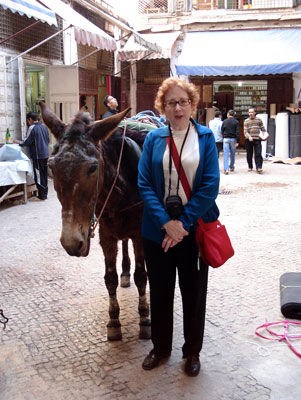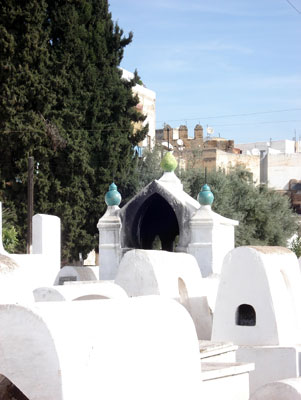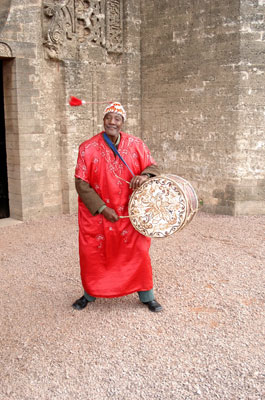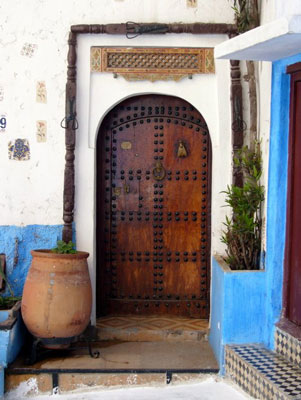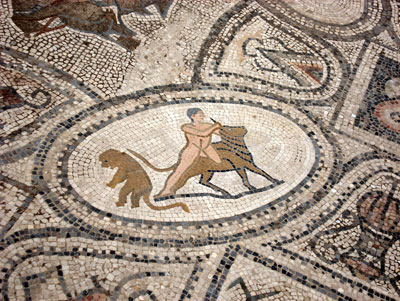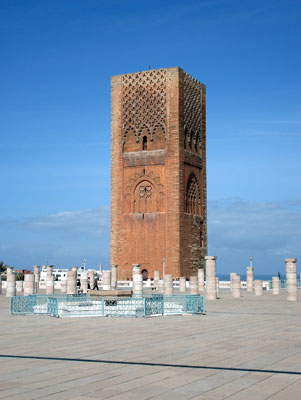Touring the ‘imperial cities’ of Morocco
by Elaine Lavine
During the summer of 2007, my nephew pursued a study program in Fès, Morocco. Some of my family joined him in August for a one-week tour of the main cities, and I became so intrigued by the travel stories they told that I made up my mind to go.
I’ve done a moderate amount of traveling, primarily in Europe, and I often travel solo, but for my first foray into North Africa I felt more comfortable going with a group. I booked my one-week March ’08 “Imperial Cities” tour of Morocco through IsramWorld (New York, NY; 800/223-7460, www.isram.com).
My family’s reports of conditions during their August visit — heat, flies, smells and inconsistent sanitation standards — were enough to discourage me from a summer visit. Going in March turned out to be a great decision. Morocco was enjoying spring, which meant pleasantly warm weather during the day, cool evenings (colder in the mountains and in the desert), cobalt-blue skies and sunshine every day of the tour.
I was also exceptionally lucky that my tour group had only four travelers, including myself. (I was told that the usual Isram group size is 10 to 20.) We traveled from city to city in a comfortable minivan with an informative and courteous English-speaking driver — practically a private tour at a group-tour price!
Casablanca
Morocco entered the 20th century under French colonial rule, gaining full independence in 1956. The current king, Mohammed VI, has addressed human rights issues and has allowed many exiles to return, but fundamental problems, such as underdevelopment, illiteracy, poverty and social inequality, remain.
With an official population of 3.1 million, Casablanca is Morocco’s largest city and the sixth-largest city in Africa. It is home to the Hassan II Mosque, designed by French architect Michel Pinseau. Situated on a promontory stretching into the Atlantic, the mosque is the second largest in the world (after the one in Mecca) and can accommodate 25,000 worshipers. A further 80,000 can be accommodated outside the mosque in the plaza.
Almost all of the materials used in its construction are from Morocco, with the exceptions of the Italian white granite columns and the glass chandeliers from Venice. The roof of the mosque, which weighs 1,000 tons, can be opened to let in air and sunshine in just three minutes and closed again in two. Panels of glass line the floor so worshipers can see the sea.
Cost estimates range up to $800 million, paid mostly by public subscription, which has led to ambivalence toward it on the part of many city inhabitants. I was told there’s a feeling that the money should have been used for social programs instead.
Unlike at most mosques, non-Muslim visitors are allowed inside but only during the four guided tours per day, which are timed so as not to interfere with daily prayer. Shoes must be removed at the entrance and carried in the provided plastic bag.
Rabat
Our visit to Morocco’s capital, Rabat, included its most famous monument, the Tour Hassan. This 44-meter-tall minaret is all that remains of an enormous mosque built around 1200 that was mostly destroyed in the Lisbon Earthquake of 1755. Besides the tower, the site includes the paved plaza coinciding with the mosque’s foundation and some reerected pillars.
Instead of by stairs, the tower is ascended via ramps, designed to allow the muezzin to ride a horse to the top of the tower to issue the call to prayer.
Also in Rabat, the Chellah Necropolis was our next stop. The very oldest element of this complex is the remains of the Roman settlement of Sala Colonia, but most of the structure dates from the early 14th century, when the sultan built a mosque (the minaret still stands) and a mausoleum for his wife. It was subsequently used to provide gravesites for him and his successors.
The current occupants of the complex are stray cats, who are apparently fed by caretakers every day, and storks who migrate there from the Sahara to nest every spring.
Fès
After a visit to Volubilis, a UNESCO World Heritage Site noted both for its architecture and the many colorful mosaics still in situ, we continued on to Fès.
For this tour, I’d chosen the top tier of hotels offered, but the only one I truly thought merited its top ratings and luxury price was the Palais Jamaï in Fès. It’s an older hotel, a converted palace built by a government official at the end of the 19th century, located right on the edge of the medina.
The service was pleasant, and the amenities and room furnishings were lovely, almost regal.
When I return to Morocco I would like to again stay there, but I will otherwise look into staying in riads, traditional homes located inside the medinas that have been converted into, often, deluxe guest houses.
Fès consists of three parts: Fès el-Bali, the original ninth-century medina, now a World Heritage Site; Fès el-Jedid, also called New or White Fès, built in 1276 and including the Mellah (Jewish Quarter) and the royal palace, and the 20th-century Ville Nouvelle.
Fès’ medina is the largest car-free urban area in the world. However, there are plenty of donkeys, mules and handcarts. We were warned that if we heard the shout, “Balak! Balak!” (meaning “Attention!”), we should quickly paste ourselves up against a wall to avoid getting trampled by a donkey or a cart loaded with wares.
Art Naji (www.artnaji.net) is a pottery factory on the outskirts of the medina. Plumes of black smoke can be seen when the medina is viewed from a distance; the smoke is from the kilns, which are fueled by crushed olive pits.
There is a wide range of goods made on the premises, from inexpensive little olive dishes to beautiful tables with tiled tops and vases adorned with silver. The real local pieces will be signed “Fès,” with perhaps an artist’s name on the underside, but the little dishes do make nice gifts.
Make sure your negotiated price includes shipping back to the US. FedEx or DHL service in Morocco is very limited, so it’s not practical to think you can ship items yourself.
Marrakech
My hotel in Marrakech was the Royal Mirage Deluxe, not to be confused with its sister hotel, the Royal Mirage. The hotel is located in a top neighborhood, across from the Theatre Royal, and was slickly decorated. The lobby is huge and impressive, as are the public areas, but the hotel did fall short.
For one thing, the lighting in the guest rooms was so dim that I could only read anything during daylight hours. I had to carry the room service menu into the bathroom in order to read it.
The famous Marrakech hotel La Mamounia was, unfortunately, closed for renovations. It had an even better location than my hotel and a long history of famous guests, such as Winston Churchill.
Sites visited in Marrakech included Bahia Palace, where I took so many pictures and could have gone on for days. Built by a grand vizier in the late 19th century to house himself, his four wives and 24 concubines, the palace featured gorgeous woodwork, carved stucco and tilework plus a serene and beautiful atrium garden.
Also visited was Majorelle Garden, the former studio and garden of artist Jacques Majorelle. It has been extensively restored and was more recently owned by the late couturier Yves St Laurent. Although in a central location, the garden and the small museum there were peaceful, at least in the off-season. Many of the surfaces were painted a vibrant cobalt blue, the bluest blue one can imagine — just gorgeous!
Shopping in Marrakech
The Herboristerie Avenzoar (78, bis Derb N’khel Rahba Lakdima) is a spice-and-herb shop in Marrakech’s souk. The owner provided a short lecture on his spices and herbs, describing many of them as having homeopathic properties.
For more herbs, cures and teas, visit Dar Argane (Avenue Houmman el Fetouaki). El Abidi Nasser Eddine, at the south end of rue Souk Semmarine, featured antique and new jewelry, and Tresor des Nomades (142-144 rue Bab Doukkala) was a treasure trove of household goods: candlesticks, bowls, tables, chairs, etc.
Just at the edge of the medina, near Djemaa el Fna, the main square, Kif Kif (8 rue des Ksours, Bab Laksour; www.kifkifbystef.com) offers clothing, jewelry, napkins, stationery and home accessories.
Travel tips
It is unlawful to take in to Morocco or bring out any amount of the local currency, the dirham. Currency exchange rates are set by the government (in March ’08 it was approximately 7.3 dirhams to one US dollar), so the rate at your hotel should be the same as your withdrawal from an ATM.
Be advised that maintaining a supply of small change in bills and coins — so necessary for the frequent tipping that is part of the culture there — isn’t easy. I found hotel desks very challenged to make change.
Waiters in proper restaurants should be tipped up to 10% of the bill. At informal cafés, the tip is normally two dirhams per person in the party. Hotel porters will appreciate 10 to 20 dirhams, as will anyone else who helps you out (e.g., the young man who guides you back to your hotel when you are lost).
While, in my experience, you are certainly not paying for much of a service, a tip of two to five dirhams to the attendants posted inside or outside of restrooms is expected. And be sure to have a supply of your own tissues and hand wipes in addition to the coins; you will need your own toilet supplies almost every time.
Most Moroccans are poor, and soliciting tips is a way of life. It may seem annoying, but these small (to us) amounts of money are welcomed.
“Petits taxis,” in distinctive colors assigned to each city, provide metered cab service in the city centers. Either ask for the meter to be turned on upon entering or find out what the price will be to your destination before you get in.
Taxi drivers do not routinely get tipped if they are using the meter, but you can add on a dirham or two. “Grands taxis” offer shared rides on specified routes.
French is a very useful language in Morocco; it is the second language spoken there after Arabic. The remarkable thing is that even the poor old woman asking for coins, who probably can’t read or write, may very well be bilingual.
Local customs
When beckoning someone, a Moroccan wouldn’t do so by using his index finger; that is considered impolite. He would make a beckoning gesture with his whole hand, palm down, sweeping the hand toward himself.
Eating with one’s fingers is a tradition in Morocco, but eat with the right hand only, using the thumb and first two fingers (more is a sign of gluttony). The left hand may be used for picking up bread or passing dishes on to other people.
Never help yourself to bread; wait until it is given to you. Bread is used to mop up sauces and clean your plate.
Don’t lick your fingers until the end of the meal. In the meantime, wipe them on the bread or a napkin.
I found that my Western-style dress (trousers and sleeved tops) served me perfectly well in Morocco. Some Moroccan women were completely covered up, but most wore only head coverings while a few were dressed in Western style. Note that you can’t enter a holy site in a sleeveless top or shorts. I’d recommend against wearing shorts, in general.
One thing I didn’t see anywhere was any women enjoying coffee or tea in a sidewalk café. That seemed to be a men-only pastime.
Guides
Official guides can be hired from tourist offices or at your hotel’s front desk. Faux guides are looking for work in this country with its high unemployment and meager social welfare, so look for a brass badge or laminated card to identify an official guide. Decide beforehand what you want to see and do, then discuss this with your guide before agreeing on an itinerary, time and cost.
It’s true that guides can receive up to 40% commission from shopkeepers in return for bringing them clients, so if you don’t want to visit any shops, be clear and firm about this before setting out with your guide.
Bargaining in Morocco
In souks, markets and medinas, expect to haggle. The best piece of advice I can give is to think ahead about what you want and how much money and time you are prepared to pay for it. You can visit the modern fixed-price shops and cooperative shops in order to gauge “standard” prices.
In medinas and souks, the starting price may be as much as four times what the seller is prepared to accept, though if the vendor senses you know the value he may start lower or come down very rapidly. You may be offered a cup of tea; it’s part of the routine but also a courtesy.
The expectation is that you don’t suggest a price you would not be prepared to pay. I found that the shopkeeper would win my sale by asking me to say or write down my very best offer. He would tell me that was too low and I was taking food from his children, then he’d write down a slightly higher price, which usually won me over.
I’m sure I offered too much to start with because I felt embarrassed, so the final price was doubtless more than the shopkeeper would have accepted, but I kept in mind the price in dollars and figured that what I might have overpaid was not really that much.
If you don’t get the price you want, you can always start at the next place with the “best and final” offer of the shop before. If you enter a shop and it doesn’t have what you want, smile, say “Thank you” (“Shokran” or “Merci”) or “Au Revoir” and leave.
Once you have bought something, don’t continue to shop around for the same thing. You will inevitably find it cheaper sooner or later, but the quality may or may not be the same and there’s no point in second-guessing your purchase. Just enjoy it.
Trip details
The current price range for IsramWorld’s 8-day “Imperial Cities” tour is $1,960-$3,860 per person, based on double occupancy. Prices depend on the level of hotel selected and the time of year. All hotel breakfasts and dinners are included.
IsramWorld subcontracted with RecepTours (www.receptours.net) in Morocco, who provided an excellent and companionable driver who was fluent in English and drove a new van. They can also arrange for knowledgeable guides in each city.


